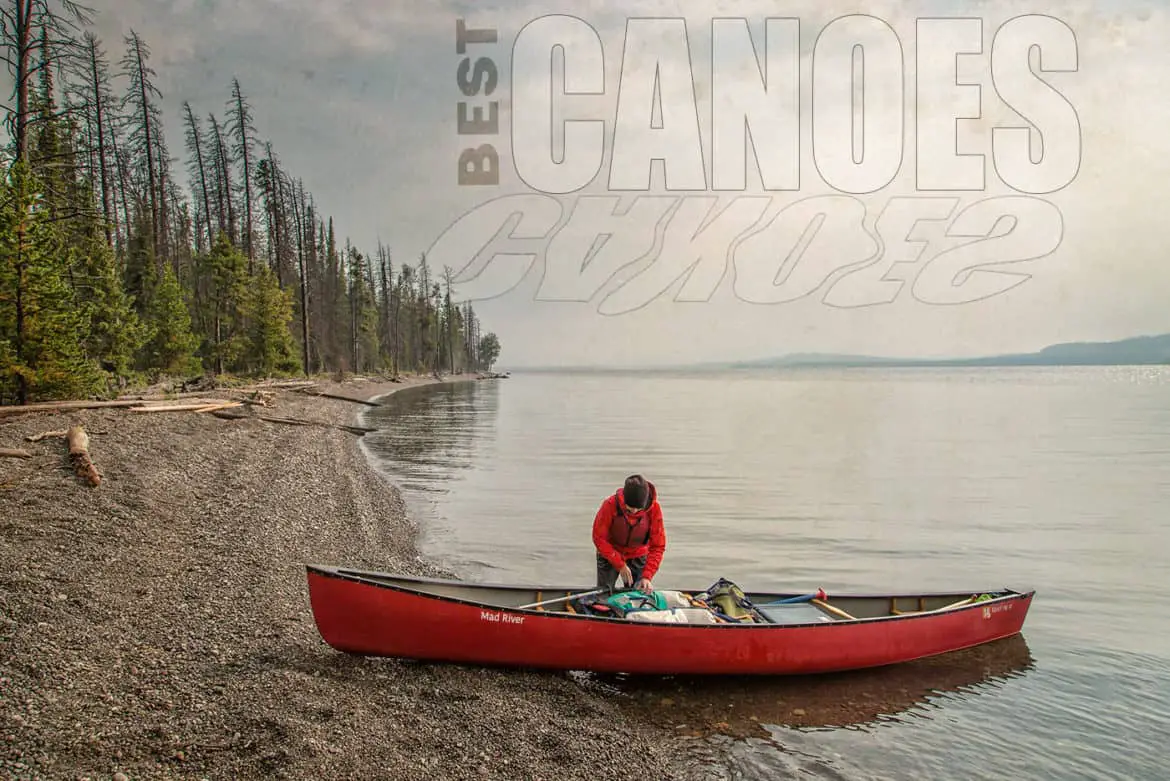Canoeing can be one of the most relaxing sports to do in nature. Not only are you out on the water, but you are able to get closer to any creature of the wild than ever because of the stealthy nature of the canoe.
In fact, if you splurge for a higher-end craft, you should not hear any noise at all (ie. plowing of the bow through the water) other than the dripping of water from your paddle between each stroke.
Being able to experience the majestic beauty found in remote waterways can be breathtaking.
While I realize that canoeing is not for everyone (I know a few families whose idea of a normal vacation is a 40-foot yacht on the high seas all day and then back to the coastal villa on a cliff in Barbados), it’s probably the one activity that benefits us more than virtually anything else!
The fresh air of a wilderness, remote location is refreshing to your body (even at a molecular level), the clean, remote, uncluttered, and wholesome environment does something for your mind, body, and soul.
I know this from first-hand experience since I’ve been an avid remote wilderness canoe-tripper for over 30 years!
Many lakes and sports shops offer canoe rentals. But maybe you’re not satisfied with occasionally renting a canoe. There’s something about owning your own domain!
If you rent, you’ll get the “guck” from other users, the scratches and wear from previous renters who didn’t care at all for the boat, and the whole experience is often tainted if you haven’t committed a portion of your own hard-earned cash for a beloved family “friend” (as I affectionately refer to my kevlar lake-tripping canoe).
If you’ve decided that you’d like to take the plunge and get your own canoe, it can be a daunting task. Canoeing is an in-depth sport there are many elements that go into purchasing your first canoe.
Sometimes all of the canoe talk can make it seem like you’ve entered a foreign country. Suddenly people are talking about yoke pads, the Stern band, the keel line; and you have no idea what any of it means.
Even experienced canoeists may not have all the information about the different design elements that make their canoe perform the way it does. So, whether you’re just beginning or you’re an old pro, buying a new canoe can be overwhelming.
Don’t worry, this guide is going to break down everything you need to know for purchasing your first, or second canoe. Take a look below to find out all of the elements that go into making a canoe perform the way you want it to.
How to Pick Your First Canoe
When first reading about canoe design it can seem like there are 50,000 elements that go into making a good canoe. The truth is that there are about six elements that you really need to consider before getting your first canoe.
You’ll want to consider the hull profile as well as the canoe profile. The rocker, entry line, and stem are the next three things that you look at before purchasing your canoe. Finally, you’ll need to consider the material from which you’d like your canoe to be constructed.
In addition to construction and design elements, there are things you can consider before purchasing a canoe such as a usage. How many people will be going in the canoe? What is the style of seating that you would like?
Considering all of these things before purchasing your canoe will enable you to enjoy your purchase at a higher level. Remember to contemplate more than function when picking out what you want in your canoe, sometimes comfort trumps function.
First, let’s take a look at the design elements of canoes and how they are going to affect the performance of the canoe.
Hull profile
There are four types of hull profiles when it comes to a canoe. Each hull profile is going to provide a slightly different performance feature for your boating experience.
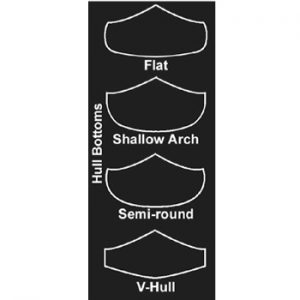
Flat Bottom
I know it sounds tricky, but flat bottom canoes have a flat bottom. There is a very little curve in the bottom of the canoe making it extremely stable on the easy water. This stability is only good up to a certain point.
Flat bottom canoes while stable when in the right position are prone to tilting due to the wind, waves, and leaning. Once you’ve tilted beyond the point of no return, there is no way to avoid capsizing a flat bottomed canoe.
These crafts are best suited for short trips with children or for casual recreation. They are stable for activities like fishing, hunting, bird-watching or photography. They are not designed for maximum efficiency on long, wilderness voyages.
They have too much contact with the water which creates drag, thereby reducing efficiency, or increasing the energy per stroke ratio.
While good for your calm water these canoes may also be best considered by experienced canoeists, who can stay in the center of their canoe without risking tipping their canoe over.
Round Bottom
Quite different from the flat-bottomed canoe, a round bottom canoe is going to have a very round belly. Round bottom canoes are designed for speed and efficiency. They can be difficult to balance in an upright position.
This is very true for inexperienced canoeists. Despite the initial instability of the round bottom canoe, they are hard to tip over. You may feel like you’re going to fall over the edge, but you probably won’t.
These designs are best for your average week-long wilderness trip on lakes and flat still water (as opposed to rivers and rapids).
Shallow Arc
A shallow arch design will give paddlers the stability that the flat bottom boats have and the flexibility that the round bottom canoes have. It is a perfect match between the two types of designs.
Shallow Vee
Slightly rounded with a V down the centerline the Shallow Vee hull design provides improved performance. The Vee down the center line provides canoeists with improved tracking.
There is a lot of surface area in a shallow V-profiled boat so that efficiency for paddling these types of canoes can go down. They are very easy to steer because of the tracking that the shallow vee provides. So, you may want to trade the speed for the maneuverability
Canoe profile
The next design element that you should consider when purchasing a canoe is the profile of the canoe. There are three basic canoe profiles that you can choose from, and they all add different elements to your canoeing trip.
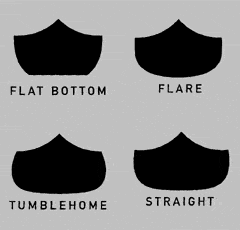
Flare
If a canoe hull is flared outward, then it is going to resist tipping. Also, the flare is going to deflect water away from the inside of the canoe making for a much drier trip.
The flare prevents backsplash from the paddle and tipping, but it may come at a cost. Some paddlers find that they tire easily when writing in a flared canoe.
This is because you are forced to reach out over the side of the canoe to paddle. It may not be a very natural way to paddle the canoe. This may be an instance of weighing pros and cons. Would you rather be dry, or a little bit tired?
Tumblehome
If your canoe features a tumblehome design, it has a wide bottom, and it turns inward at the top. These canoes are best when you want to maximize your paddling stroke. They allow you to dip your canoe paddle straight into the water and slide right down the gunwale.
Straight Side
The final canoe profile that you are likely to see as a straight-sided canoe. This does not have a flair outward or does not tumble inward. There is no particular benefit or drawback to having a straight-sided canoe. Some people just like the way they look.
If you’re looking for a specific performance element in your canoe profile than the flare or tumblehome are going to be what you need to consider.
Rocker
The rocker on the canoe is how much curve there is from the entry point to the back of the boat. There are heavy rockers, moderate rockers, or straight-line rocker canoes.
A canoe with a heavy rocker is going to be much easier to maneuver, but it will not go straight as well as a flat line canoe. Most people prefer a moderate rocker on their canoe because it is a nice mix of maneuverability and tracking.
Straight keels (no rocker) are best for lake water tripping since they provide maximum tracking efficiency (the canoe goes straighter longer and doesn’t steer one way and then the other with each paddle stroke).
Extreme rockers (not like Ozzy Osbourne) are great for whitewater river canoeing since they provide maximum maneuverability to avoid rocks and choose the best path through narrow runs.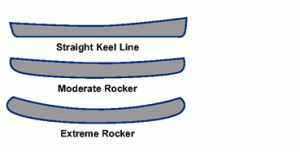
Entry Line
The entry line is the front tip of your canoe. Canoes that feature a sharp entry line are going to have lots of efficiency and speed in the water. Unfortunately, the sharp entry line decreases their ability to handle heavy waves.
Those with a blunted entry line are going to have a lot more buoyancy in a wavy environment.
The entry line of your canoe should be primarily considered when choosing where you are going to be canoeing most. If you know that you are just going to be on small lakes than you can probably handle a more narrow entry line.
However, if you plan on experiencing Whitewater in your canoe, a blunted entry line is going to be much better for you.
Stem
The stems create the shape of the canoe at the bow and stem, and a square stem improves tracking while a rounded stem improves steering and maneuverability.
Deciding where you will be doing the majority of your canoeing first will allow you to select better what type of stem is going to be best for your purchase.
Material
Traditional canoes were made by hands out of wood and birch bark. The Hot pitch was used to seal the seams of the bark to keep the canoes afloat. Today there are many options when it comes to the materials your canoe can be made from.
Most canoes today are either plastic or a composite material. Composite Canoes are very durable and can withstand a lot of usage.
On the plastic canoes, many of them are molded from a single piece of plastic, and they can feature no seams, which is nice for the durability of the canoe. There are plenty of choices, even all-metal canoes.
Choosing the material may just depend on your ecological preference.
Usage
Before you even begin to purchase your canoe, you should consider what you are going to be using your canoe for. There are typically four usages for canoes, and each one of them may require different design or construction elements.
If you plan on fishing from your canoe, you’re going to want a very stable very wide canoe. Storage space on a fishing canoe is going to be more important than space on a touring canoe.
Check out these four types of canoeing and see what special considerations you should have when purchasing a canoe for these activities.
Fishing
When fishing from a canoe, stability may be one of the most important features that you can have. Along with stability, you are going to want to make sure that you have a lot of space in the bow of your boat. Having room to put your tackle, fishing pole, and other gear is very important when fishing from a canoe. You’re not going to be able to fish if you cannot fit all of your gear in your canoe.
River
When canoeing on a river, you really want to consider how much maneuverability your canoe has. If your canoe does not have easy stop-go and turn abilities, you’re not going to fare well in river conditions.
While maneuverability wouldn’t matter as much in a fishing canoe, it definitely matters when you are on a Whitewater River. Additionally, you’ll want the toughest material (and most resilient) possible.
Aluminum is okay, but NOT KEVLAR! You’ll want to look for tough materials that are, unfortunately, the heaviest. You don’t want to portage a whitewater canoe! Extreme rocker design for your hull would be your best bet for whitewater since you’ll need maximum maneuvering capabilities.
Expedition
Expedition Canoeing typically lasts multiple days. You’re going to need to make sure that your canoe can handle multiple water conditions. Along with that, you will need to make sure that you can fit any gear, food, or cooking equipment inside of your canoe.
Dry storage may be an essential feature on a canoe if you are taking a longer excursion. Another huge consideration for expedition canoes is weight.
You’ll probably be carrying this canoe on your shoulders for hundreds of yards, and if your canoe is a heavy beast, you’ll never want to go on another wilderness trip if you’re looking for a “vacation”.
Keep this hull design to virtually no rocker (straight keel line – refer to the diagram above) since you’ll want maximum tracking efficiency.
Recreation
When you are recreation canoeing, you will not be as concerned about the construction of the canoe than with any other type of canoeing. If you’re just paddling around the lake for half a day.
You really are not going to be too concerned with the stem or rocker on your canoe recreation canoeing probably means that you can opt for a less expensive canoe because of the infrequency of use and the type of water you will be on.
Seating
Seating may not seem like the most important element in choosing a canoe, and it may even be the last thing on your mind. But if you have any issues with your back, hips, legs, knees; you need to pay attention to the back support provided by your canoe.
Most canoes come with a simple bench style seating that you can upgrade with the purchase of a separate seat. Other canoes do come with an integrated backrest-style seat.
If you need back support make sure that you are purchasing a canoe that can support a backrest style seat.
Best Canoe/Accesory Ideas
Lifetime Kodiak 13-Foot Canoe – great for recreation
This Kodiak canoe is only 13 feet long and weighs 96 pounds, which means it is anything but a wilderness tripping canoe. But then, it never claimed to be.
What it is meant for is a recreational and/or casual fishing canoe with rod holders, cup holders, comfortable molded seats and backrests. The seatbacks are removable with quick-release mechanisms and it features luggage-style handles for easy carrying.
With high initial stability and included motor mount (rated for 40-pound thrust electric motor), it’s well-equipped to do its job. The body itself is made from UV-Protected blow-molded high-density Polyethylene and it can seat up to 3 paddlers.
The 600-pound weight capacity is ample and its construction renders it impact-resistant. Users report excellent stability for most tasks.
Pros
- Great for Beginners
- Nearly indestructible
- moderate rocker allows for a wide variety of uses
- Rigged for fishing and features motor mount
Cons
- weighs twice as much as a kevlar touring canoe of the same length
Old Modern Handicrafts Wooden Canoe
We just have to include this canoe in our reviews since it’s arguably the best-looking watercraft (that can call itself a “canoe”) that we’ve ever seen! This canoe is for those who love to paddle but also want a showpiece to brag about for (potentially) generations!
There are simply NO other canoes (that we could find) that match this one in workmanship and timeless beauty! It’s completely handmade (and by the way, it takes around FIVE HUNDRED HOURS to make this beauty) with Western Red Cedar strips.
The strips are joined together by hand and then the whole thing is bonded in place with epoxy resin and then coated with marine-grade varnish. We love that the varnish does not add any excessive color or fog. It’s completely transparent and virtually colorless.
This allows the beauty of the wood to show through AND be protected for more than a few decades!
This gorgeous boat is 18 feet long, 35.5 inches wide, and has a 15-inch bow height. It weighs 65 pounds which is VERY reasonable for a wood canoe. Some fiberglass canoes are considerably heavier! It features a 650-pound weight capacity.
Please note that this canoe is meant to be used but treated with respect. It also comes with a set of equally premium and gorgeous paddles.
Pros
- First canoe we’ve seen that offers timeless beauty and excellent functionality
- At 65 lbs, it’s made to be carried by 1 person
- Most versatile of all options
Cons
- Jack of all Trades, Master of none (but still, one heck of a good Jack, that’s for sure!)
- You may feel like you need to “baby” this boat while using it since it is a visual masterpiece and could potentially be damaged with careless use
Sun Dolphin Mackinaw Canoe
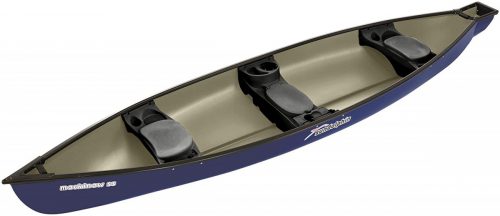
The Sun Dolphin Mackinaw looks like it is designed to be the ultimate recreational canoe. This canoe comes with a cooler under the center seat, storage compartment, paddle holders, and beverage holders molded into every seat.
It seems like Sun Dolphin was really trying to make this canoe a great option for the recreational user.
The canoe has a capacity for three seating with the center seat being the third seat.
None of the seats have back support so if you are looking for something that will support your back while out on the water you may have to purchase additional seating to go inside of this canoe.
The Sun Dolphin Canoe is made of dent-resistant and UV-resistant material. Unfortunately, some experienced that the dent-resistant material wasn’t as sturdy as it could have been.
If you are in water that has lots of hidden hazards this boat may take some damage. It is not made of aluminum or metal it is a polymer blend plastic.
In high heat, this boat will warp so make sure that you do not purchase this boat if you are in an area that gets extreme heat.
This canoe is not designed for fishing it does not feature any fishing rod holders. There really isn’t a whole lot of stability if a single person is on the canoe. So, solo fishing from this canoe is really not possible.
If you plan on going out with a friend fishing may be ok, just plan on holding your rod the whole time.
What we found surprising about this canoe is that the manufacturer has no information other than material about the design of the canoe.
Most canoes have their Rocker, Hull profile, and other design elements listed so that you can purchase knowing what to expect when you get your canoe.
These don’t have any design elements listed, and it is really a guessing game until you get your canoe. When looking at the bottom of the boat, the design was unlike many traditional canoes, which may be why they do not list their design elements.
The straying from traditional canoe design may be why these canoes are more tippy than others.
Pros
- 800 LB Capacity
- 3 Seater
Cons
- May dent easily
- Inexperienced May Experience Tipping
Old Town Discovery 119 Canoe
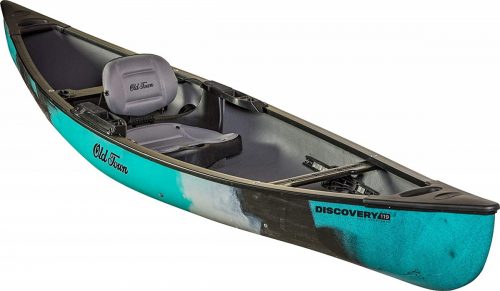
The old town discovery 119 is a single person canoe. This canoe has a slim profile with its width of 32.5-inches, and its depth is 13.5 inches.
The nice thing about this solo canoe is it weighs in at 49 pounds making it easy for one person to get it in and out of the water. The maximum capacity on this canoe is up to 500 pounds.
If you’re planning a long trip, this canoe is going to be perfect because it will fit you, as well as, a lot of gear. It’s called the “119” because it’s length is 11’9″.
The basic construction elements for the Discovery 119 include a shallow arch bottom, straight sides, and a moderate rocker. The gunwales are made of vinyl the rest of the canoe is a lightweight relay or polyethylene.
The seat on this canoe is a web seat with no back support. If you’re looking for comfort in seating this canoe doesn’t have it. Some people were able to create back support for the canoe on their own. If you want back support built-in, try looking at a different canoe.
This is a solo canoe, so you are not going to be traveling with anyone else in this canoe. It’s very basic design allows you to get where you’re going rather quickly.
The slim profile makes this canoe ideal for a double-bladed kayak paddle which can increase the speed that you travel across the water.
The Discovery 119 is a stable and easy to handle canoe, but it is not suited for Whitewater or fast River conditions. This canoe is best suited for calm waters because of the moderate rocker.
If you’re looking for a medium line canoe that you can run by yourself, the Discovery 119 is a great solo canoe.
Pros
- Triple Layer Polyethylene
- 49 pounds
- 500-pound load capacity
Cons
- Solo Canoe
- Mesh Seat
5. Old Town Next Watercraft
Okay, full disclosure! This is your author/reviewer’s favorite canoe! Yes, it’s true. Why? Well, I spend a lot of time on the water alone, and this canoe was made for someone like me specifically. I can use a kayak paddle or a canoe paddle, and it’s wonderfully easy to control when compared to a 2-person canoe being used solo. It also happens to be made very well since Old Town is a decades-old iconic brand in the canoe industry. In fact, I dare say Old Town is the WORLD’s oldest and largest canoe maker! Take that one to the bank!
It’s thirteen feet long with a wonderful tumblehome (which most solo canoes have plenty of) and it’s made of triple-layer polyethylene. It has a minimal rocker which allows for straighter, smoother travel (which is harder to achieve with a single canoeist). The 450-pound weight capacity is huge for a 13-foot solo canoe and it features a support track foot brace system as well!
Pros
- Designed specifically for a solo canoeist
- Arguably the best name in canoes worldwide
Cons
- At 59 pounds, it won’t break any light weight records – especially for solo canoes which can weigh as little as 29 or 30 lbs.
6. Grumman 15 ft Symmetrical Canoe
Grumman is a well-known brand in canoes and kayaks. In fact, it’s a given in the industry that Grumman “owns” the aluminum canoe market. The selling point of a Grumman is basically that it’s nearly indestructible, relatively inexpensive and is an “all-around Jack of all trades”. That’s basically true since the design is a compromise of just about everything. It has an average rocker and a bit of tumblehome as well, but its weight makes it impractical for wilderness tripping. It’s definitely not a purist’s canoe. It’s built like a tank, not a Ferrari, and it leaves much to be desired in the area of comfort.
However, most Grummans have good initial stability (that means it doesn’t feel too tippy if you move around a bit) which can be deceiving since good initial stability means very BAD secondary stability (which is the one that counts). Secondary stability means you’ll have a hard time actually tipping the canoe if you really lean over, and most Grummans have poor secondary stability. On the positive side, the draft is very shallow so you can bring this boat into just a few inches of water and still not be grounded (depending on the load of course)
The solid and very tough aluminum design of the canoe makes it a very sturdy canoe for traveling water that may be full of hazards.
Just in case we didn’t make the case earlier, let’s be clear on this point; Grumman is the absolute KING of aluminum canoes. Purists won’t opt for aluminum for a variety of reasons, and we understand. However, aluminum fits the bill perfectly for quite a number of people including outfitters who need canoes to last forever no matter what, or anyone concerned about the durability of their craft. I own a Grumman, and the reason I bought it was that I needed not to worry about putting a hole in it! My 15-footer is also very stable (I can stand in it easily). The bad part is that it’s not as streamlined as some fancy kevlar models (ie. Wenonah), and it’s heavier. It’s kind of a “no-frills” craft that you can’t really “hurt”.
The “double-ender” part of the equation is another feature I like about most Grummans, and that is that because the canoe is symmetrical, you can make either end the “front”. The seating is configured such that if you’re canoeing solo, you actually sit backwards on the seat that would otherwise be the front seat during a trip with two paddlers!
It’s a good “all-around” utility canoe that works for wilderness tripping (albeit with slightly less efficiency than a Wenonah), and also for family fun off the end of the dock, bird-watching, or any other possible reason you’d need a canoe (except for racing – then I’d suggest a RACING canoe :))
The problem with having a metal canoe is that the canoe may heat up to high temperatures in the sun and heat. Make sure that you are prepared to cool the metal before getting into your canoe. For those who can’t figure it out, that means flop that sucker into the water and it’ll be cool within 20 seconds! Or, do as I do, and never really take the entire canoe out of the water so it never gets a chance to heat up without the heat being dissipated by the canoe’s connection to the water!
Pros
- Symmetrical so either end can be the front
- Nearly indestructible for use with kids, camps and casual cottage fun
- Shallow draft
Cons
- Good or adequate at lots of things but spectacular at none – other than taking a beating against the rocky shoreline or submerged obstacle
- Aluminum will get hot
- Not an efficient canoe for fast, flat water travel or long-distance wilderness trips.
7. Old Town Canoes & Kayaks Discovery Sport 15 Square Stern Canoe
Old Town is one of those companies that has been around for over 120 years so they’ve kind of figured some things out wouldn’t you say? The Discovery Sport Square Stern Canoe fills a niche that not too many companies dare to go. While it can be used to paddle on its own by either 1 or 2 people, the Discovery Sport shines when you slap on a 4 H.P. outboard motor and let er rip!
Because it was built to accommodate a motor, it features extra stability by way of full-length stabilizing chines for rigidity. It’s constructed with 3 layers of polyethylene for long-lasting durability, and the whole deal includes three nylon web seats, black, vinyl gunwales (upgrade from natural aluminum), carry handles, oar socket and lock kit and a good dose of fun.
It’s not a light boat at 113 pounds, but it hold up to 1700 pounds so that’s a good trade-off. Note that with a motor, the weight capacity decreases to 850 pounds but what the hey – you can’t have it all!
It measures around 40″ in width, 15″ in depth and has a bow height of about 25″-26″. All around, this is a top choice for anyone looking to mount a motor on a canoe. If you’re not specifically looking to mount a motor and don’t have imminent plans to do so, I’d suggest grabbing just about any other canoe on our list that does not feature a square stern.
Pros
- Classic name in the industry and the company is over 120 years old
- Perfect for anyone looking to mount a motor on a canoe
- Super durable and long-lasting due to construction technique
Cons
- Very heavy, so no one will look forward to moving this beast over land without a trailer or a couple of strong dudes (or dudettes!).
8. Old Town Discovery 169 Two-Person Recreational Canoe
For starters, this boat is 16’9″ long (thus the name “169” in the official title). That’s an excellent length for efficiency on the water, but there are other factors that can work against that efficiency. The 169 has one big flaw working against its efficiency and it also makes it tough to consider this canoe as a serious tripping canoe. That issue is WEIGHT! A good tripping canoe of this length should be between 35 lbs and 50 lbs. However, the Old Town comes in at 91 lbs which virtually disqualifies it for any purpose other than cottage recreation. Thankfully, Old Town understands this and has classified it as a fishing/recreation canoe.
It has a fairly impressive load capacity of 1400 lbs, and it’s made of a tough 3-layer polyethylene which is perfect for cottage fun. The only better canoe would be a Gumman aluminum for cottage recreation. This Old Town is made for 2 paddlers and it’s 37″ wide which is pretty generous. It’s 15″ deep from gunwales to floor which is also pretty good for maximizing load and storage capacity.
Old Town is the oldest canoe maker in the world (which is good) but it has lost its spot at the top of the heap for high-end quality and efficient canoes (which is bad). If you don’t need a super fast, light and efficient canoe, and you’re looking for cottage or casual camping recreation, this may be a good choice. One last thing to consider: Be sure you’re in decent shape and you have a canoe partner who is also. Otherwise, at just under 100 lbs, you’ll have a tough time chucking this beast onto your car/truck/van roof and carrying it to the water, etc.
Pros
- Very versatile
- Great load capacity
- Rocker and Tumblehome designed for broad usage or purpose
- Great brand
Cons
- Heavier than many wilderness tripping canoes
- Not comfortable to carry if using the included yoke
Conclusion & Recommendations
You now have all the information you need to choose a canoe that’s going to be right for you and your family. Remember when shopping for canoe the things that you need to consider are:
- How will you be using your canoe?
- How many people will be in the canoe?
- What are the main water conditions where you plan to travel or frequent with your canoe?
- What are the features that I cannot live without?
While it may seem silly to skip over a canoe because it doesn’t feature built-in cupholders; if a cupholder is something that is important to you make sure you get it.
Most of today’s recreational canoes have built-in features designed to make your canoeing trip as comfortable as possible. Coolers, cupholders, and dry storage compartments have almost become standard features and most canoes.
As far as choosing the best recreational canoe you can’t go wrong with Saranac 146. This is the perfect all-around canoe.
It will take your family on many canoe trips in comfort and style. It’s not designed for those who are looking for intense whitewater or sporting canoe trips, but rather nice family outings.
It’s important to check the listings carefully to see if canoe paddles are included or sold separately.
Since the Saranac 146 is also great for the fisherman in the family, it’s hard not to recommend this canoe as our top choice. Having a multifunctional canoe is really important when you’re investing a great amount of money into your canoe.
If you’re going to be hitting the water solo, the best canoe that we found was the Old Town Next Canoe. This canoe is a funky hybrid between kayaking canoe that features an asymmetrical design with a high storage capacity.
Any solo canoeist or peddler that needs 450 pounds of hauling capacity is going to love this canoe. It has a sharp tumblehome feature making paddling a lot easier than on the straight or flared sidewall canoes. This was just a well rounded single person canoe.
All of the canoes that we listed are great, it just depends on what features you need for the canoe that will work best for you. Sometimes it just comes down to budget and any of the moderately-priced canoes are going to work wonderfully in any budget.
Just remember to make sure that your canoe has all the features that match your lifestyle and canoeing preferences.
Don’t hesitate to grab your new canoe and hit the water to see how well it works for you. If you took our advice, I’m sure you found the perfect canoe for you and your family to use all season long. Enjoy that canoe trip.

